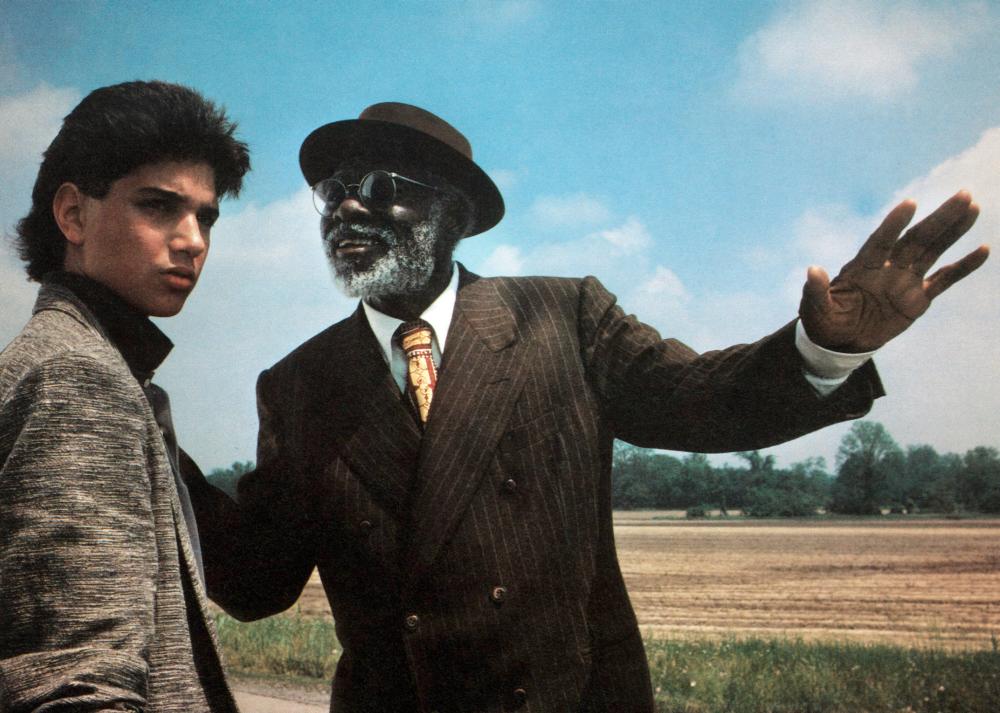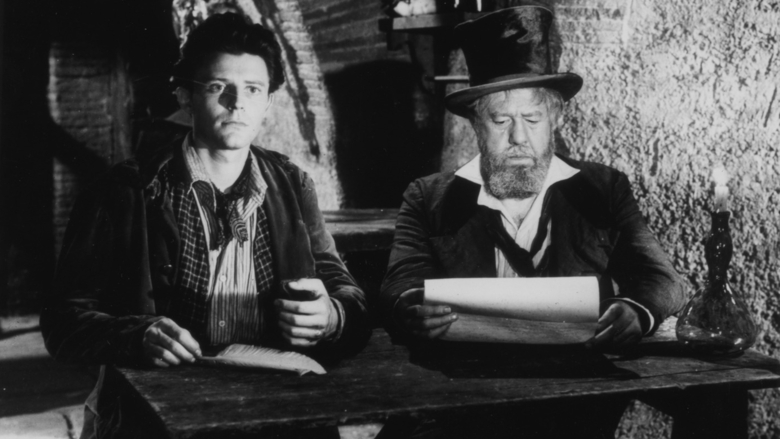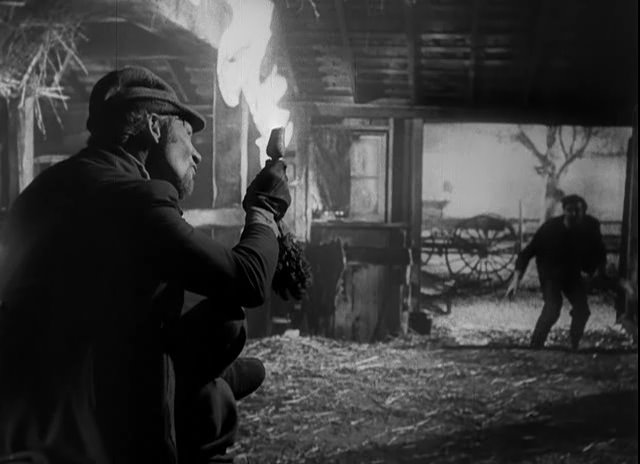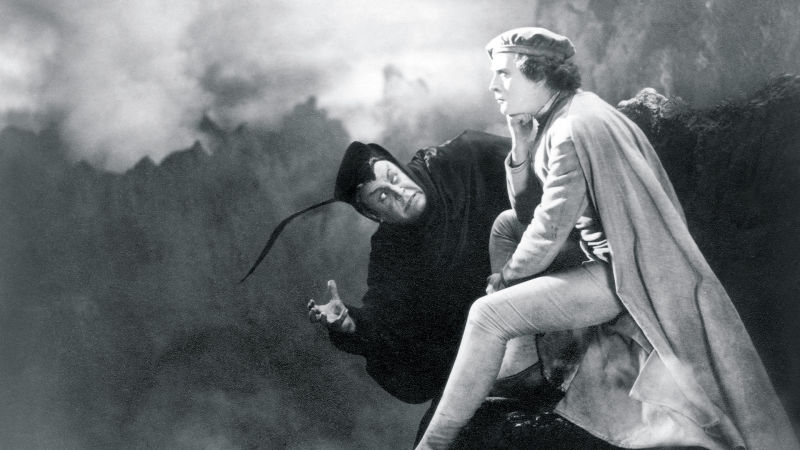5. Crossroads (Walter Hill, 1986)

Written by John Fusco while he was still a student, this American twist on Faust was inspired by the mystery behind blues guitarist Robert Johnson and the legend behind his talent. Ralph Macchio stars as Eugene, a Juliard trained guitarist who becomes obsessed with the blues history of America, especially with Robert Johnson. He tracks down a former bandmate of Johnson, Willie Brown, played by Joe Seneca, in a jail for the elderly.
In order to learn about Johnson and his lost song, Eugene agrees to break Willie out and accompany him down to to the South where he has unfinished business to attend to. They hitchhike down, meeting a young runaway, played by Jamie Gertz, who Eugene falls in love with.
When they reach their destination, Willie reveals that he has signed his soul away to the devil and the only way to get it back is to duel him at guitar. Eugene offers to compete for him, putting up his own soul as collateral, and takes on the devil, played by guitarist Steve Vai.
Crossroads was made at the beginning of the downturn of director Walter Hill’s career, still more focused than his recent endeavors, but far from the talent shown in his early films like The Warriors and The Driver. In many ways, the film is not all that original, and many of the plot points feel a bit hackneyed.
Despite this and the less-than-polished execution of the film, it is still incredibly entertaining due to the good acting and the fresh approach to the Faust legend, mixing the old stories with Western Voodoo mythology and the lore of the blues musician.
4. Beauty and the Devil (Rene Clair, 1950)

From French auteur Rene Clair comes this fresh satirical retelling of the Faust legend. Michel Simon is Prof. Henri Faust who has aged greatly and, despite dedicating his life to the practice of alchemy, has not attained a solid understanding on life’s mechanisms. He is confronted by a young Mephistopheles, who promises to give him youth and a fresh start in exchange for his soul. Faust accepts and the two switch appearances.
While Faust is initially set on continuing his studies, to uncover the secrets of nature, he soon becomes sidetracked. He discovers that his new good looks make him much more successful with women and they soon become the full focus of his time. All the while, Mephistopheles plots to trick Faust into an early termination.
Like much of Clair’s work, Beauty and the Devil is not only an engaging fantasy film but also connotations regarding society at the time. It is also the least damning of all the Faust interpretations on this list, portraying both Faust and the Devil as humane, relatable characters and because of this their actions are more moving.
The focus of Clair’s story also differs from many of the interpretations. Instead of emphasizing the sin of greed, it attaches to the transformation of the character, showing that there was a lot more to life than he previously thought.
3. Rosemary’s Baby (Roman Polanski, 1968)

A twist on the traditional telling of the story, Polanski’s adaptation of a novel by Ira Levin shows the tale from a different perspective. Mia Farrow stars as Rosemary, a housewife married to her husband Guy, played John Cassavetes, who is struggling to make his career as an actor. They move into an old apartment building which has a mysterious backstory and although things seem to go well initially, they soon take a turn for the worse.
Unbeknownst to Rosemary, Guy has been approached by the satanist cult in the building and has been coaxed into a deal with the devil. In the deal he gains fame and success as an actor but in exchange he trades his wife’s body.
One of the masterpieces of Polanski’s controversial career, Rosemary’s Baby was a landmark horror movie that, along with The Exorcist, raised the reputation of the studio horror film, showing that they can actually be of substance as well as scare people.
This film deviates from the Faust myth probably more than any other film on this list and the troubles of the protagonist are of a different, more helpless nature. Still, the twist on the classic story is a very interesting project and due to the mysterious forces being more in the shadows, the themes are arguably more terrifying.
2. The Devil and Daniel Webster (William Dieterle, 1941)

Based on the short story by American writer Stephen Vincent Benet, this great film by German director William Dieterle, who acted in the next film on this list, is a classic American resetting of the Faust tale. Set in New Hampshire a decade in the 1840s, the film follows Jabez Stone, a poor farmer, who can’t provide for his family and is about to be foreclosed on by his lender.
Sensing vulnerable prey, the devil, alias Mr. Scratch, played by Walter Huston, shows up and offers Jabez seven years of good fortune and riches, at the end of which the devil collects him.
Desperate and without options, Jabez signs and buys things for his wife and parents, as well as pay off the property. He meets the famed speaker and lawyer Daniel Webster and befriends the man. Things are looking up for Jabez, but soon he becomes arrogant with his success and he even leaves his wife for the mysterious Belle, played by Simone Simon.
After it is too late, he realizes the mistakes he has made and tries to undo his deal with the devil by appealing in a trial with Daniel Webster representing him and a jury made up of the worst Americans in history, such as Benedict Arnold.
This film is a great example of how easily the classic story can be molded to fit any environment. It completely embraces the American culture of the time while keeping the theme and messages of the tale. The performances all around are fantastic and the camera work in many ways was ahead of its time, showing the chaotic descent of Jabez Stone.
The effects were also impressive, especially the ghost jury at the end of the film. Although the film was not a hit upon its release, its reputation has continued to grow over time, now being regarded as one of the great early fantasy films of Hollywood.
1. Faust (F.W. Murnau, 1926)

Filmmaker Friedrich Wilhelm Murnau was one of the pioneering forces behind the German Expressionist movement, responsible for, among other things, the horror classic Nosferatu. As a German, he had always wanted to make an adaptation of the Faust legend and finally, as the last film he made in Germany, Murnau created this masterpiece.
The film’s plot borrows mostly from Goethe’s play but also takes influence from the older, traditional tales. The film begins with the devil Mephistopheles, played by the great Emil Jannings, who makes a bet with an angel that if he can corrupt a good man, he will win Earth. He targets an alchemist Faust and casts a plague on his city. After Faust loses faith in God, Mephistopheles slowly gains his trust until he gets Faust to sign away his soul.
Then the devil plot to ruin his life, turning the town against him, and tricking his lover into killing their child. Faust, however, shows that love is greater than despair and stays with his wife as they are burned at the stake, ascending into heaven and stumping the devil.
There are many incredible aspects of this film. It’s powerful story is very moving and the acting is superb. The special effects are probably the first thing to come to mind, however, for those who have seen the film. Typical of Murnau, the camera trickery and innovate techniques create absolutely stunning images and fantastical scenes, many of which are still awe-inspiring today, despite the advances in special effects.
The production was immense for German film industry of the time, only surpassed in magnitude by Fritz Lang’s Metropolis, and today the film is regarded as a landmark film in the German Expressionist movement. It also impressed those in Hollywood and gave Murnau a chance to make American films, leading the way to his most acclaimed film, Sunrise.
Author Bio: Matthew Benbenek is an undergraduate Mechanical Engineering student at the University of Wisconsin – Madison. He has a passion for film, music and literature and, when not watching movies, is an amateur director and violin player.